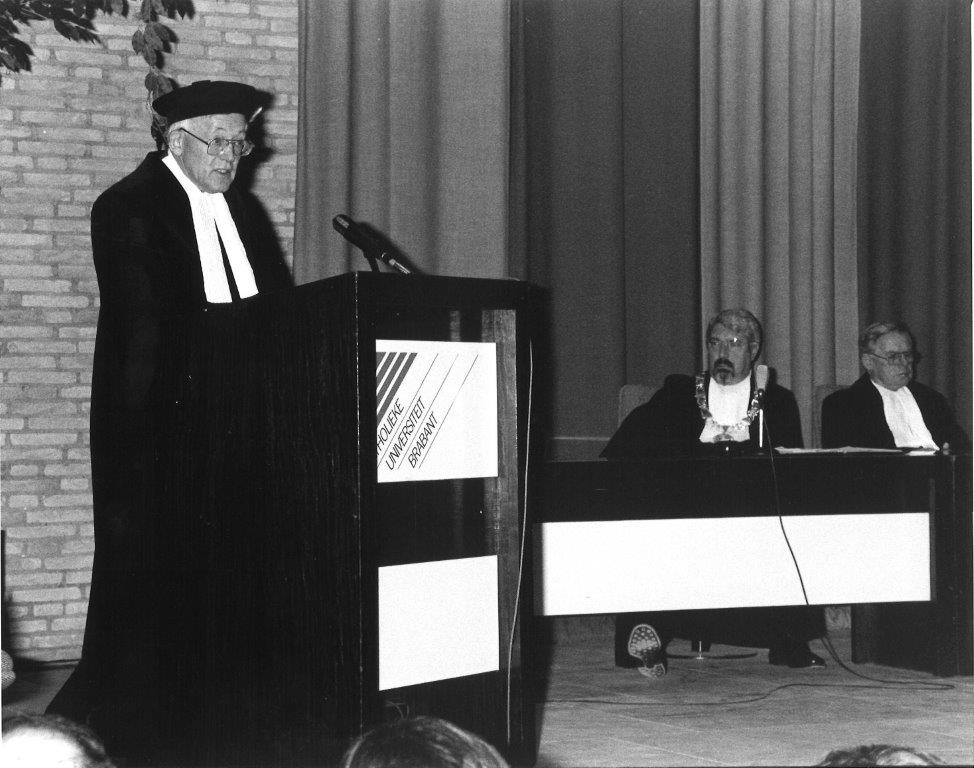Johan de Vries and the historiography of the university
Each month, Academic Heritage project leader Pieter Siebers places distinctive events, people, buildings, or objects in historical perspective. This time: Johan de Vries and the historiography of the university.

Only recently did we learn that historian Johan de Vries had died, on October 13, 2021, at the age of 94. De Vries played an important role in the historiography of this institution in the period when it was still known as Katholieke Hogeschool Tilburg. He was Professor of Economic History from 1967 until 1981 and Professor by Special Appointment of Economic History from 1982 until 1992. In the latter period his main job was as economic historian of the Dutch Central Bank.
De Vries is the author of the second volume of the historiography of what is now Tilburg University, which was founded in 1927 as Katholieke Handelshoogeschool Tilburg (and would subsequently change its name several times). It covers the period from 1955 to 1977 and appeared in August 1981, three years after the first volume, which was written by Hans Bornewasser. De Vries described, in almost 450 pages (including notes etc.), a turbulent period in which the university experienced great growth, moved from the inner city to the campus in 1962 and welcomed two new schools and the sub-school of Psychology. In addition, the institution was in the news for briefly displaying “Karl Marx University” on its facade in the spring of 1969 and because of the first university occupation in the Netherlands in April 1969.
Nestor of company historians
De Vries studied economics at the University of Amsterdam, where he obtained his PhD (cum laude) in 1959 with the thesis De economische achteruitgang der Republiek in de achttiende eeuw (The Economic Decline of the Republic in the Eighteenth Century). He focused on company history and wrote the Gedenkboek van de Kamer van Koophandel Amsterdam (1961) (Memorial Book of the Amsterdam Chamber of Commerce) and Geschiedenis der chemische industrie (1961) (History of the Chemical Industry). He was also the author of books with a broader character such as Moderne geschiedenis van Nederland (1965) (Modern History of the Netherlands) and Ontsloten poorten, vijftig jaren volksuniversiteit in Nederland 1913-1963 (Unlocked Gates, Fifty Years of Adult Education Institutes in the Netherlands 1913-1963). In 1972, he was approached for the historiography of the university, which he initially declined because he shrank from committing himself “for a long time to a task bristling with unforeseen and foreseen pitfalls.”
De Vries, who has been characterized as the Nestor of Dutch company historians, thus pointed out the problem of historians who work on commission and who, moreover, usually have to immerse themselves in living history as well. They have to deal with issues whose nature and significance are not always immediately apparent and about which opinions are often divided. In the preface to the second volume of the Tilburg Historiography, De Vries writes about this that his approach differs from that of Bornewasser, author of the first volume) when it comes to “tone and interpretation,” but also “that what is now offered is exclusively the vision of the author and therefore entirely his responsibility.”
It is not impossible that in writing these rules, De Vries was thinking of his not always benevolent observations on the democratization of education that took shape in the early 1970s and his characterization of the “new” student, coming from backgrounds where an academic education was not a given. De Vries, himself a somewhat stately man, recalls in his book that Ton Koster, one of the later occupiers, was the first student to wear jeans in 1966. There is something of disdain about it, and the perception of people themselves is missing. On the other hand, such passages illustrate De Vries’s eye for detail, without losing sight of the big picture.
Detachment and freedom
De Vries, who retired from the institution in 1992, documented a time of detachment and new freedoms, himself balancing between distance and involvement. His historiography is still worth reading over forty years after it was published and was rightly reprinted in 2004 on the occasion of the 75th anniversary of the university, when the third volume was also published. At its presentation, a video portrait of De Vries was shown and commented on by Jochen Bläsing and Karel Veraghtert, professors who had also devoted themselves to company history.
The latter was one of the authors of volume three, which deals with the period 1977-2022. In 2027, Tilburg University will celebrate its centenary and that is a good opportunity not only to focus on the last 25 years. The importance and significance of the insights and developments of the years that have been chronicled by De Vries also deserve attention in such a fourth volume. If only because, as Goethe wrote, the generations of today keep discovering what the previous ones have forgotten.
Pieter Siebers is an art historian and responsible for Tilburg University’s academic heritage. He is affiliated with the Executive Services Division and wrote, among other things, de Kleine encyclopedie – Tilburg University 1927-2017 (Brief History in English), which highlights the past and present of the institution. More information about the history of the university can be found on the heritage portal.
Translated by Language Center, Riet Bettonviel






